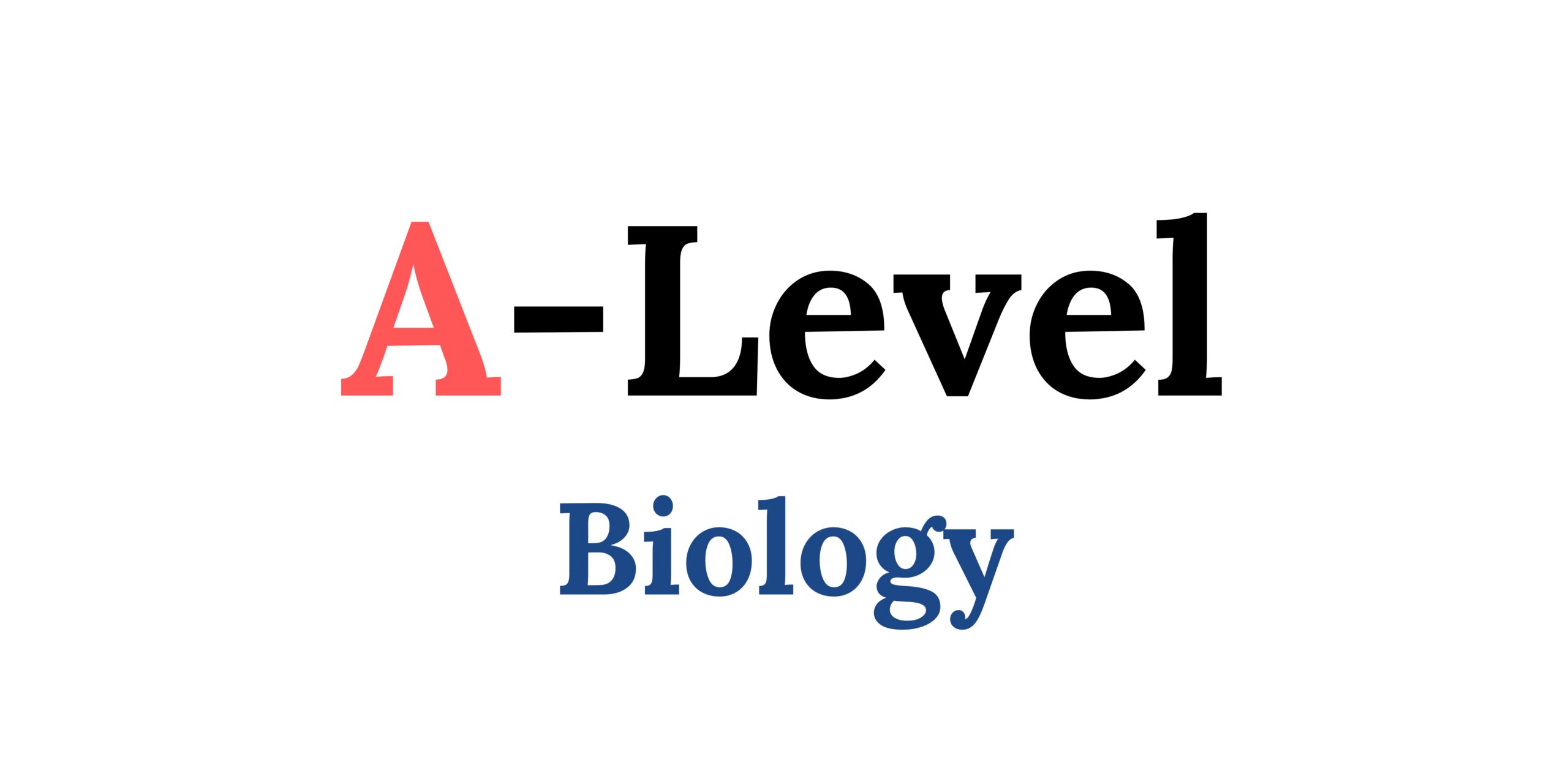
Overview of AQA A-level Biology qualifications
Subject content:
Want to learn more about Advanced Level Qualifications (A-Levels) and how they can shape your academic future? Click here to explore: A-Level Information.
1. Biological molecules
| Syllabus component | Content |
|---|---|
| Monomers and polymers | • The biochemical basis of life • Monomers (e.g., monosaccharides, amino acids, nucleotides) • Polymers • Condensation Reaction • Hydrolysis reaction |
| Carbohydrates | • Monosaccharides: The building blocks of carbohydrates (e.g. glucose, galactose, fructose) • Condensation Reaction • Formation of Disaccharides: Maltose, sucrose, lactose • Polysaccharides: Glycogen and starch, Cellulose • Structure and functions of: glycogen, starch and cellulose in animal and plant cells • Biochemical tests using Benedict’s solution to determine reducing and non-reducing sugars, and potassium iodide/potassium iodide to determine starch. |
| Lipids | • Triglycerides: Formed from glycerol and three fatty acids by condensation to form ester bonds • R-group of a fatty acid: saturated and unsaturated • Phospholipids • The different properties of triglycerides and phospholipids are due to their different structures. • Emulsion test for the detection of lipids |
| Proteins | • General properties of proteins: – Amino acids, and the general structure of an amino acid – Formation of Dipeptides and Polypeptides – Role of hydrogen bonds, ionic bonds and disulfide bridges in protein structure – Functions of proteins – Relation between primary, secondary, tertiary and quaternary structure and function of protein – Biuret test for the determination of proteins • Proteins in the role of enzymes: – A model of induced compliance of enzyme action – Enzyme properties |
| Nucleic acids | • Structure of DNA and RNA • DNA replication |
| ATP | Definition and formation of ATP |
| Water | Properties of water |
| Inorganic ions | Types, role and properties of ions |
2. Cells
| Syllabus component | Content |
|---|---|
| Structure of eukaryotic cells | • cell surface membrane • nucleus • mitochondrion • chloroplasts (in plants and algae) • Golgi apparatus and Golgi vesicles • lysosomes • ribosomes • rough endoplasmic reticulum and smooth endoplasmic reticulum • cell wall (in plants, algae and fungi) • cell vacuole (in plants). |
| Structure of prokaryotic cells and of viruses | • Structure of prokaryotic cells and viruses • Differences from eukaryotic cells |
| Methods of studying cells | • Principles and limitations of microscopes • Optical microscopes: measuring size, understanding magnification and differences in resolution. • Use of the formula: Principles of cell fractionation and ultracentrifugation as used to separate cell components |
| The emergence of cells from other cells | • Mitosis • The stages of the cell cycle: interphase, prophase, metaphase, anaphase, and telophase (including cytokinesis) • The appearance of cells at each stage of mitosis |
| Transport across cell membranes | • simple diffusion • facilitated diffusion • osmosis • active transport • co-transport |
| Cell recognition and the immune system | • Antigen definition • Phagocytosis of pathogens • Reaction of T-lymphocytes to foreign antigen (cellular response) • The role of antigen-presenting cells in the cellular response • The role of helper T cells (TH cells) in the stimulation of cytotoxic T cells (TC cells), B cells and phagocytes • B-lymphocyte response to foreign antigen, clonal selection and release of monoclonal antibodies (humoral response) • Definition of an antibody • Structure of an antibody • Formation of antigen-antibody complex • The role of plasma cells and memory cells in the production of primary and secondary immune response • The use of vaccines to protect individuals and populations from disease. The concept of herd immunity • Differences between active and passive immunity |
| HIV | • The structure of human immunodeficiency virus (HIV) and its replication in helper T cells • How HIV causes the symptoms of AIDS. Why antibiotics are ineffective against viruses • The use of monoclonal antibodies • Ethical issues surrounding the use of vaccines and monoclonal antibodies • The use of antibodies in the ELISA test |
3. Organisms exchange substances with their environment
| Syllabus component | Content |
|---|---|
| Surface area to volume ratio | • Surface Area to Volume Ratio • Adaptations in Larger Organisms • Metabolic Rate |
| Gas exchange | • Adaptations to gas exchange: unicellular organisms, insects, fish, plants. • Structural and functional trade-offs between gas exchange efficiency and water loss in terrestrial insects and xerophytes. • The human gas exchange system • Ventilation • Effects of disease and environmental pollution |
| Digestion and absorption | • Digestion Overview • Mammalian Digestion • Absorption in the Ileum |
| Mass transport | • Mass transport in animals: – Hemoglobins and Hemoglobin – The role of hemoglobin and red blood cells in oxygen transport – Bohr effect – General scheme of blood circulation in mammals – General structure of the human heart – The structure of arteries, arterioles, and veins as related to their function – Structure of capillaries and formation of tissue fluid • Mass transport in plants: – Xylem – Cohesion-tension theory of water transport in xylem – Phloem – Mass flux hypothesis for the mechanism of translocation in plants – The use of tracer and ring experiments to study transport in plants |
4. Genetic information, variation and relationships between organisms
| Syllabus component | Content |
|---|---|
| DNA, genes and chromosomes | • DNA in Cells: Prokaryotes, Eukaryotes • Genes • Eukaryotic DNA |
| DNA and protein synthesis | • The genome and the proteome • RNA structure: mRNA, tRNA • Transcription as the production of mRNA from DNA • The role of RNA polymerase in joining mRNA nucleotides • Translation as the production of polypeptides from the sequence of codons carried by mRNA • The roles of ribosomes, tRNA and ATP |
| Genetic diversity | • Gene mutations • Mutagenic agents • Meiosis and the process of meiosis |
| Genetic diversity and adaptation | • Natural selection and its principles in the evolution of populations • Directional selection |
| Species and taxonomy | • Species Identification • Phylogenetic Classification • Binomial Nomenclature • Taxonomic Systems |
| Biodiversity within a community | • Biodiversity • Species Richness • Index of Diversity • Impact of Farming |
| Investigating diversity | • Genetic diversity estimated by comparison: – Observed characteristics – DNA base sequences – The base sequences of mRNA – Amino acid sequences of proteins encoded by DNA and mRNA • Quantitative investigations of variation within a species |
5. Energy transfers in and between organisms
| Syllabus component | Content |
|---|---|
| Photosynthesis | • Light-dependent reaction • Light-independent reaction (Calvin cycle) • Environmental factors that limit photosynthesis. |
| Respiration | • Glycolysis and its steps • Anaerobic Respiration • Aerobic Respiration |
| Energy and ecosystems | • Plants and Biomass • Gross Primary Production (GPP) • Net Primary Production (NPP) • Net Production of Consumers (NPC) • Primary productivity • Secondary productivity |
| Nutrient cycles | • Nutrient recycling • Role of saprobionts in decomposition • Role of mycorrhiza in facilitating plant uptake of water and inorganic ions • Role of bacteria in nitrogen cycling |
6. Organisms respond to changes in their internal and external environments
| Syllabus component | Content |
|---|---|
| Internal and external stimuli and reactions | • Survival and response • Receptors • Control of heart rate |
| Nervous coordination | • Nerve impulses • Synaptic transmission |
| Skeletal muscle contraction by nerves | • Muscle Contraction • Muscle Structure • Key Components in Contraction: Actin and Myosin, Calcium Ions and ATP, Calcium Ions and Tropomyosin, ATP and Phosphocreatine • Muscle Fibre Types: Slow Muscle Fibres and Fast Muscle Fibres |
| Homeostasis | • Principles of homeostasis and negative feedback • Control of blood glucose concentration • Control of blood water potential |
7. Genetics, populations, evolution and ecosystems
| Syllabus component | Content |
|---|---|
| Inheritance | • Genotype and Phenotype • Alleles • Genetic Diagrams • Statistical Analysis: Use of the chi-squared test to compare observed and expected phenotypic ratios |
| Populations | • Species and Populations • Genetic Concepts: Gene Pool, Allele Frequency • Hardy–Weinberg Principle |
| Evolution and Speciation | • Variation and Genetic Factors • Natural Selection • Speciation Types: allopatric (geographic separation) and sympatric (same area) speciation • Genetic Drift |
| Populations in ecosystems | • Community and Ecosystem • Estimating Population Size • Ecosystem Dynamics and Succession • Involves managing succession to conserve habitats |
8. The control of gene expression
| Syllabus component | Content |
|---|---|
| Gene mutations in the process of DNA replication | • Understanding mutations • Consequences of mutations |
| Gene expression | • Totipotent Cells • Types of Stem Cells: Pluripotent, Multipotent and Unipotent, Unipotent, Induced Pluripotent Stem Cells (iPS) • Stem Cell Applications • Regulation of transcription and translation • Gene expression and cancer |
| Using genome projects | • Sequencing projects • Applications • Complex organisms • Advances |
| Gene technologies | • Recombinant DNA technology • Use of labeled DNA probes and DNA hybridization to locate specific gene alleles • Genetic fingerprinting |
Assessment
| Type of assessment | Questions | Final score | Weighting of final grade |
|---|---|---|---|
| Paper 1 | 76 points: mixture of short- and extended-response questions 15 points: extended response questions Any content from topics 1-4, including relevant practical skills | 91 marks | 35% of A-level |
| Paper 2 | 76 points: mixture of short and extended answer questions 15 points: comprehension question Any content from topics 5-8, including relevant practical skills | 91 marks | 35% of A-level |
| Paper 3 | 38 points: structured questions that include practical techniques 15 points: critical analysis of the experimental data presented 25 points: one essay with a choice of two titles Any content from topics 1-8, including relevant practical skills | 78 marks | 30% of A-level |
Required practical activities
1. Investigate how a specific variable affects the rate of an enzyme-controlled reaction.
2. Prepare stained squashes of plant root tip cells, and use an optical microscope to identify mitosis stages and calculate the mitotic index.
3. Create a dilution series of a solute to produce a calibration curve for determining the water potential of plant tissue.
4. Investigate how a specific variable impacts the permeability of cell membranes.
5. Dissect a gas exchange or mass transport system in plants or animals, or an organ within such a system.
6. Apply aseptic techniques to study how antimicrobial substances affect microbial growth.
7. Use chromatography to analyze pigments from leaves of different plants, such as shade-tolerant and shade-intolerant plants or leaves of various colors.
8. Investigate how a specific factor influences dehydrogenase activity in chloroplast extracts.
9. Investigate the effect of a specific variable on the respiration rate of single-celled organism cultures.
10. Examine how an environmental variable affects animal movement using a choice chamber or maze.
11. Create a dilution series of a glucose solution and use colorimetry to develop a calibration curve to determine glucose concentration in an unknown “urine” sample.
12. Investigate how an environmental factor influences the distribution of a particular species.
If you need help with Biology or any other subject, our tutors are ready to support you on your academic journey. Don’t miss your chance to succeed—take a trial lesson today!
Weighting of assessment objectives for A-level Biology
Exams will assess students on the following objectives:
AO1: Demonstrate knowledge and understanding of scientific concepts and methods.
AO2: Apply knowledge in theoretical and practical contexts, including data handling.
AO3: Analyze, interpret, and evaluate scientific information to make judgments, draw conclusions, and improve practical designs and methods.
| Assessment objectives AOs* | Paper 1 (%) | Paper 2 (%) | Paper 3 (%) | Total Weighting (%) |
|---|---|---|---|---|
| AO1 | 44–48 | 23–27 | 28–32 | 30–35 |
| AO2 | 30–34 | 52–56 | 35–39 | 40–45 |
| AO3 | 20–24 | 19–23 | 31–35 | 25–30 |
| Total weight of components | 35 | 35 | 30 | 100 |
Assessment weightings
Marks will be scaled to meet component weightings. Final marks are the sum of scaled component marks. Grade boundaries are set using total scaled marks.
| Сomponent | Maximum raw mark | Scaling factor | Maximum scaled mark |
|---|---|---|---|
| Paper 1 | 91 | ×1 | 91 |
| Paper 2 | 91 | ×1 | 91 |
| Paper 3 | 78 | ×1 | 78 |
| Total scaled mark: | 260 |











